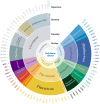Tick-Borne Viruses
- PMID: 29536246
- PMCID: PMC5866268
- DOI: 10.1007/s12250-018-0019-0
Tick-Borne Viruses
Abstract
Ticks are important vectors for the transmission of pathogens including viruses. The viruses carried by ticks also known as tick-borne viruses (TBVs), contain a large group of viruses with diverse genetic properties and are concluded in two orders, nine families, and at least 12 genera. Some members of the TBVs are notorious agents causing severe diseases with high mortality rates in humans and livestock, while some others may pose risks to public health that are still unclear to us. Herein, we review the current knowledge of TBVs with emphases on the history of virus isolation and identification, tick vectors, and potential pathogenicity to humans and animals, including assigned species as well as the recently discovered and unassigned species. All these will promote our understanding of the diversity of TBVs, and will facilitate the further investigation of TBVs in association with both ticks and vertebrate hosts.
Keywords: Identification; Isolation; Tick-borne viruses (TBVs); Ticks.
Conflict of interest statement
Conflict of interest
The authors declare that they have no conflict of interest.
Animal and Human Rights Statement
This article does not contain any studies with human or animal subjects performed by any of the authors.
Figures
Similar articles
-
Tick-borne viruses.Acta Virol. 2017;61(4):413-427. doi: 10.4149/av_2017_403. Acta Virol. 2017. PMID: 29186958 Review.
-
The Known and Unknown of Global Tick-Borne Viruses.Viruses. 2024 Nov 21;16(12):1807. doi: 10.3390/v16121807. Viruses. 2024. PMID: 39772118 Free PMC article. Review.
-
Emerging Tick-Borne Viruses in the Twenty-First Century.Front Cell Infect Microbiol. 2017 Jul 11;7:298. doi: 10.3389/fcimb.2017.00298. eCollection 2017. Front Cell Infect Microbiol. 2017. PMID: 28744449 Free PMC article. Review.
-
Tick-Borne Viruses and Biological Processes at the Tick-Host-Virus Interface.Front Cell Infect Microbiol. 2017 Jul 26;7:339. doi: 10.3389/fcimb.2017.00339. eCollection 2017. Front Cell Infect Microbiol. 2017. PMID: 28798904 Free PMC article. Review.
-
Transmission and evolution of tick-borne viruses.Curr Opin Virol. 2016 Dec;21:67-74. doi: 10.1016/j.coviro.2016.08.005. Epub 2016 Aug 28. Curr Opin Virol. 2016. PMID: 27569396 Review.
Cited by
-
Kyasanur Forest Disease Classification Framework Using Novel Extremal Optimization Tuned Neural Network in Fog Computing Environment.J Med Syst. 2018 Sep 1;42(10):187. doi: 10.1007/s10916-018-1041-3. J Med Syst. 2018. PMID: 30173290 Free PMC article.
-
Virome diversity shaped by genetic evolution and ecological landscape of Haemaphysalis longicornis.Microbiome. 2024 Feb 21;12(1):35. doi: 10.1186/s40168-024-01753-9. Microbiome. 2024. PMID: 38378577 Free PMC article.
-
First Record of a Suspected Human-Pathogenic Borrelia Species in Populations of the Bat Tick Carios vespertilionis in Sweden.Microorganisms. 2021 May 20;9(5):1100. doi: 10.3390/microorganisms9051100. Microorganisms. 2021. PMID: 34065313 Free PMC article.
-
Tick-borne viruses and their risk to public health in the Caribbean: Spotlight on bats as reservoirs in Cuba.Heliyon. 2024 Feb 9;10(4):e26118. doi: 10.1016/j.heliyon.2024.e26118. eCollection 2024 Feb 29. Heliyon. 2024. PMID: 38375245 Free PMC article. Review.
-
Phylogeography and Re-Evaluation of Evolutionary Rate of Powassan Virus Using Complete Genome Data.Biology (Basel). 2021 Dec 6;10(12):1282. doi: 10.3390/biology10121282. Biology (Basel). 2021. PMID: 34943197 Free PMC article.
References
-
- Abramova LF, Terskikh II, Terskikh IF, Gromashevskii VL, Gromashevskii VF, L’Vov DK. Comparative characteristics of the pathogenicity of 2 viruses of the family Rhabdoviridae for monkeys. Vopr Virusol. 1987;2:357–359. - PubMed
-
- Afonso CL, Amarasinghe GK, Banyai K, Bao Y, Basler CF, Bavari S, Bejerman N, Blasdell KR, Briand FX, Briese T, Bukreyev A, Calisher CH, Chandran K, Cheng J, Clawson AN, Collins PL, Dietzgen RG, Dolnik O, Domier LL, Durrwald R, Dye JM, Easton AJ, Ebihara H, Farkas SL, Freitas-Astua J, Formenty P, Fouchier RA, Fu Y, Ghedin E, Goodin MM, Hewson R, Horie M, Hyndman TH, Jiang D, Kitajima EW, Kobinger GP, Kondo H, Kurath G, Lamb RA, Lenardon S, Leroy EM, Li CX, Lin XD, Liu L, Longdon B, Marton S, Maisner A, Muhlberger E, Netesov SV, Nowotny N, Patterson JL, Payne SL, Paweska JT, Randall RE, Rima BK, Rota P, Rubbenstroth D, Schwemmle M, Shi M, Smither SJ, Stenglein MD, Stone DM, Takada A, Terregino C, Tesh RB, Tian JH, Tomonaga K, Tordo N, Towner JS, Vasilakis N, Verbeek M, Volchkov VE, Wahl-Jensen V, Walsh JA, Walker PJ, Wang D, Wang LF, Wetzel T, Whitfield AE, Xie JT, Yuen KY, Zhang YZ, Kuhn JH. Taxonomy of the order Mononegavirales: update 2016. Arch Virol. 2016;161:2351–2360. doi: 10.1007/s00705-016-2880-1. - DOI - PMC - PubMed
-
- Al-Khalifa MS, Diab FM, Khalil GM. Man-threatening viruses isolated from ticks in Saudi Arabia. Saudi Med J. 2007;28:1864–1867. - PubMed
-
- Al’khovskii SV, L’Vov DK, Shchelkanov M, Shchetinin AM, Deriabin PG, Samokhvalov EI, Gitel’man AK, Botikov AG. The taxonomy of the Khasan virus (KHAV), a new representative of phlebovirus genera (Bunyaviridae), isolated from the ticks haemaphysalis longicornis (Neumann, 1901) in the Maritime Territory (Russia) Vopr Virusol. 2013;58:15–18. - PubMed
Publication types
MeSH terms
LinkOut - more resources
Full Text Sources
Other Literature Sources
Medical


